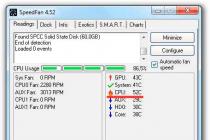Rivalry is the main determinant of progress. The race for profit provokes the development of all new technologies. This is why most large companies invest millions of dollars to improve their products. Thus, on the modern market every day more and more new products with improved characteristics appear. These processes have not spared mobile phones either.
So, Apple recently presented new flagship in the world of mobile devices - which naturally has its competitors:
- Sony Xperia Z4 and X;
- Htc one(M9);
- Xiaomi Mi5;
- Huawei P9;
- OnePlus 3 is a flagship killer.
To understand what exactly we are losing when buying a "seven" is possible only by examining in detail all the pros and cons of other top-end phones.
Feature Sony Xperia Z4 and X
The Sony company dates back to the distant 1946, when Akio Marita and Masaru Ibuka founded Totsuko in Tokyo (as Sony was formerly called). Since, this organization is developing rapidly. One of her latest inventions is a series of mobile Xperia phones Z4 and Xperia X.
Xperia Z4
 The Xperia Z4 is an earlier creation than the Xperia X. Runs on Android Lollipop and Qualcomm Snapdragon 810. The size of the display is 5.4 inches at a resolution of 2560x1600. The RAM is 4 GB, while the permanent memory is 32/64 GB. This series stood out with an amazing main camera with a resolution of 20.7 megapixels. The front camera is more familiar - 5 megapixels. ICE flash, of course, is present.
The Xperia Z4 is an earlier creation than the Xperia X. Runs on Android Lollipop and Qualcomm Snapdragon 810. The size of the display is 5.4 inches at a resolution of 2560x1600. The RAM is 4 GB, while the permanent memory is 32/64 GB. This series stood out with an amazing main camera with a resolution of 20.7 megapixels. The front camera is more familiar - 5 megapixels. ICE flash, of course, is present.
Xperia X
The Xperia X is the latest in phenomenal performance. The first thing that catches your eye is the camera. It even surpassed the previous model, accumulating as much as 23 megapixels. The front camera is also not left behind - 13 megapixels (a special offer for lovers of "selfies" and video conversations). Shooting has Full HD resolution, at a frame rate of 60 / s. Plus, phase focus allows for perfect shooting of dynamic objects.
Also, this smartphone is armed with:
- 6 nuclear processor Qualcomm Snapdragon 650, clock frequency which is 1.8 GHz (you can safely install demanding games and programs);
- memory capacity - 64 GB, which can be increased using micro SD up to 200;
- operating system Android version M (6.0).
 As for the battery capacity, its capacity is 2620 mAh, which is not the largest, but far from the smallest. Duration of one charge = 48 hours. At the same time, this phone charges very quickly.
As for the battery capacity, its capacity is 2620 mAh, which is not the largest, but far from the smallest. Duration of one charge = 48 hours. At the same time, this phone charges very quickly.
The only drawback that you can blame the data Sony models- this is a high price, although many call it acceptable, given all the advantages.
Features of HTC One (M9)
HTC is a very young, world-renowned corporation founded by Cher Wang, HT Cho and Peter Chou in 1997 in Taiwan and quickly found its place in the electronics industry. In 1998 they invented the first touch screen, in 2006 the organization released HTC MTeoR - the world's first 3G smartphone, and by 2015-2016 a new flagship of mobile phones - HTC One (M9) was presented.
Solid-looking metal HTC One (M9) has provided its users with a lot of positive emotions. A large display (5.5 inches), a powerful eight-core processor, a capacious 3000 mAh battery, support for a micro SD of 2 TB are the main advantages of this series. In addition, the M9 has in its arsenal:
- camera (front - 5 Mp., main - 13 Mp.);
- memory (operational - 3 GB, built-in - 32 GB.);
- operating system - Android 6.0 Marshmallow;
- minimum weight (170 gr.).
 It is also worth noting that the phone comes with a unique case and htc headphones.
It is also worth noting that the phone comes with a unique case and htc headphones.
The disadvantages often include the lack of protection against moisture, NFC and a fingerprint scanner, as well as the size (for a woman's hand the phone is too big, but this is compensated by an excellent grip on the skin).
Xiaomi Mi5
Xiaomi is one of the youngest companies from of this list, but not the most lagging behind. It was founded in 2010 by eight partners led by Lei Jun (China). At the moment, this "giant" has in its turnover more than five billion dollars and produces only products top class, without wasting "on trifles". So, in 2016, this organization released its new creation - Mi5.
Famous for Xiaomi Mi5:
- 64-bit quad core Qualcomm processor Snapdragon, with a processor frequency of 1.8 GHz;
- graphics accelerator Adreno 530;
- a high-quality 16-megapixel main camera and a 4-megapixel front camera (plus a two-color ice flash is worth noting);
- powerful battery - 300 mAh;
- operating system Android 6.0 Marshmallow with original MIUI 7 interface.
 Also Mi5 has 3 gigabytes random access memory and 32 GB. built-in. It has a compass, barometer, accelerometer, and a fingerprint scanner.
Also Mi5 has 3 gigabytes random access memory and 32 GB. built-in. It has a compass, barometer, accelerometer, and a fingerprint scanner.
By cons this phone can be attributed to a slippery coating (most users note that the device "runs away" from almost any inclined surface), but it fits comfortably in the hand.
Huawei P9
The largest mobile phone company in China is Huawei. Founded  and the organization in 1987 by Ren Zhengfei, who in addition was a member of the PLA of China. On yes
and the organization in 1987 by Ren Zhengfei, who in addition was a member of the PLA of China. On yes
At present, the company has a turnover of about $ 60 billion. One of the top Huawei inventions is the P9.
The main distinguishing features of this device are:
- metal case;
- dual 12 megapixel Leica camera (this brand is one of the best cameras in the world);
- battery capacity - 3000 mAh;
- more
16.5 million colors; - front camera - 8 megapixels;
- processor frequency - 2.5 MHz;
- Fingerprint's scanner.
It is also worth noting that the P9 is based on special software - Huawei EMUI 4.1, has a unique Huawei Kirin 955 processor, is equipped with 3 GB of RAM and 32 GB of built-in memory. The diagonal of the screen is 5.2 inches.
LG Group is one of the largest South Korean financial and industrial groups (chaebols). The cash turnover of this company is over $ 80 billion. LG was formed through the merger of Lucky and Goldstar. Heart of the giant p  located in Seoul (Republic of Korea), and the body has spread to 80 countries, with more than 200 representations. One of the newest inventions is mobile phone LG G5 SE.
located in Seoul (Republic of Korea), and the body has spread to 80 countries, with more than 200 representations. One of the newest inventions is mobile phone LG G5 SE.
Characterizing the G5 SE, it is worth noting that this model has a fully metallized case (unlike previous models), which significantly improved the external performance. Also striking are the two main cameras, 16 and 8 megapixels - a wide shooting angle - 135%, The recording takes place with a resolution of 3840x2160 pixels. As for the main characteristics, they are not much different from the top flagships:
- battery - 2800 mAh;
- the presence of a fingerprint scanner;
- display diagonal - 5.3 inches;
- screen resolution - 1440x2560 pixels;
- color gamut - 167 million;
- OP - Android 6.0;
- processor frequency - 1.8 MHz;
- RAM - 3 GB;
- front camera - 8 megapixels;
- fast charging (up to 100% per hour).
Among the minuses, it is worth highlighting the difficulties in finding replaceable modules, as well as their high price. Also, many users complain about the prohibitive cost of the phone, dim screen and weak battery.
OnePlus 3 - "flagship killer"
OnePlus is the youngest company on our list, founded in December 2013 by Pete Lau. The headquarters of this organization is located in Shenzhen, Guangdong province, China. OnePlus is a unique brand that has conquered a huge audience with no more than three years on the market, thereby pushing giants like HTC, Apple and others. The newest creation of the hands of this company is the OnePlus 3 - the "flagship killer".
Why this device so they call it not difficult to understand, it is enough to evaluate all the characteristics. You can start with the cameras: the main eye has 16 megapixels and has a stabilization system (eliminating interference from a shaking hand); the front one has 8 megapixels, while it is equipped with special technical  nology that allows you to automatically photograph a smiling face.
nology that allows you to automatically photograph a smiling face.
Also worth highlighting is the combination of the Qualcomm Snapdragon 280 chipset and a mind-boggling amount of RAM - 6 GB, after which we can confidently say that this is the most powerful flagship of phones to date. In addition, all other characteristics fully meet the maximum requirements of the modern market:
- processor 4 cores, 2.2 GHz;
- 64 GB ROM;
- display size - 5.5 inches;
- video accelerator Adreno 530;
Among the disadvantages is a weak battery - 3000 mAh (for such a powerful phone this will not be enough). But it makes up for fast charging- full battery in just an hour.
conclusions
Having analyzed a considerable number of the coolest phones, we can definitely say that the competitors of the iphone 7 are very strong rivals, which will not be easy to defeat in the struggle for the love of the audience. Some are distinguished by their power, others by a super camera, the third by a capacious battery and reliability. That is why it is impossible to say definitely which of the contenders deserves the 1st place. This is due to the subjective preferences of each of us and the insignificant difference between the devices.
In turn, the iPhone itself also has its pros and cons. Its characteristics are not very different from other flagships, somewhere they exceed, and in some cases even inferior. People will be able to give a final answer only after years of operation.
Information about the brand, model and alternative names of a specific device, if any.
Design
Information about the dimensions and weight of the device, presented in different units of measurement. Used materials, offered colors, certificates.
| Width Width information - refers to the horizontal side of the device in its standard orientation during use. | 67.1 mm (millimeters) 6.7 cm (centimeters) 0.22 ft (feet) 2.64 in (inches) |
| Height Height information - refers to the vertical side of the device in its standard orientation during use. | 138.3 mm (millimeters) 13.83 cm (centimeters) 0.45 ft (feet) 5.44 in (inches) |
| Thickness Information about the thickness of the device in different units measurements. | 7.1 mm (millimeters) 0.71 cm (centimeters) 0.02 ft (feet) 0.28 in (inches) |
| The weight Information about the weight of the device in different units of measurement. | 138 g (grams) 0.3 lbs (pounds) 4.87 oz (ounces) |
| Volume The approximate volume of the device, calculated based on the dimensions provided by the manufacturer. Refers to devices with a rectangular parallelepiped shape. | 65.89 cm³ (cubic centimeters) 4 in³ (cubic inches) |
| Colors Information about the colors in which this device is offered for sale. | Black Silver Pink gold Golden Red |
| Materials for the manufacture of the case Materials used for the manufacture of the device body. | Aluminium alloy |
| Certification Information about the standards by which this device is certified. | IP67 |
SIM card
The SIM card is used in mobile devices to store data that certifies the authenticity of mobile service subscribers.
Mobile networks
A mobile network is a radio system that allows multiple mobile devices to communicate with each other.
| GSM GSM (Global System for Mobile Communications) is designed to replace the analog mobile network (1G). For this reason, GSM is often referred to as a 2G mobile network. It is enhanced by the addition of GPRS (General Packet Radio Services) and later EDGE (Enhanced Data rates for GSM Evolution) technologies. | GSM 850 MHz GSM 900 MHz GSM 1800 MHz GSM 1900 MHz |
| CDMA CDMA (Code-Division Multiple Access) is a channel access method used in communications in mobile networks... Compared to other 2G and 2.5G standards like GSM and TDMA, it offers more high speeds data transfer and the ability to connect more consumers at the same time. | CDMA 800 MHz (A1660) CDMA 1700/2100 MHz (A1660) CDMA 1900 MHz (A1660) |
| CDMA2000 CDMA2000 is a group of 3G mobile network standards based on CDMA. Benefits include stronger signal strength, fewer network outages and interruptions, support for analog signal, wide spectral coverage, etc. | 1xEV-DO Rev. A (A1661) |
| TD-SCDMA TD-SCDMA (Time Division Synchronous Code Division Multiple Access) is a 3G standard for mobile networks. It is also called UTRA / UMTS-TDD LCR. It was developed as an alternative to the W-CDMA standard in China by the Chinese Academy of Telecommunication Technologies, Datang Telecom and Siemens. TD-SCDMA combines TDMA and CDMA. | TD-SCDMA 1900 MHz (A1660) TD-SCDMA 2000 MHz (A1660) |
| UMTS UMTS stands for Universal Mobile Telecommunications System. It is based on the GSM standard and refers to 3G mobile networks. Developed by 3GPP and its biggest advantage is to provide more speed and spectral efficiency thanks to W-CDMA technology. | UMTS 850 MHz UMTS 900 MHz UMTS 1700/2100 MHz UMTS 1900 MHz UMTS 2100 MHz |
| LTE LTE (Long Term Evolution) is defined as a fourth generation (4G) technology. It is developed by 3GPP based on GSM / EDGE and UMTS / HSPA with the aim of increasing the capacity and speed of wireless mobile networks. The subsequent development of technologies is called LTE Advanced. | LTE 700 MHz Class 13 LTE 700 MHz Class 17 LTE 800 MHz LTE 850 MHz LTE 900 MHz LTE 1700/2100 MHz LTE 1800 MHz LTE 1900 MHz LTE 2100 MHz LTE 2600 MHz LTE-TDD 1900 MHz (B39) LTE-TDD 2300 MHz (B40) LTE-TDD 2500 MHz (B41) LTE-TDD 2600 MHz (B38) LTE AWS (B4) LTE 700 MHz (B12) LTE 800 MHz (B18) LTE 800 MHz (B19) LTE 800 MHz (B20) LTE 1900+ MHz (B25) LTE 800 MHz (B26) LTE 800 MHz SMR (B27) LTE 700 MHz APT (B28) LTE 700 MHz de (B29) LTE 2300 MHz (B30) |
Mobile technology and data rates
Communication between devices in mobile networks is carried out using technologies that provide different data transfer rates.
Operating system
An operating system is the system software that controls and coordinates the operation of hardware components in a device.
SoC (System on a Chip)
A system on a chip (SoC) integrates all the major hardware components of a mobile device into a single chip.
| SoC (System on a Chip) A system on a chip (SoC) integrates various hardware components such as a processor, graphics processor, memory, peripherals, interfaces, etc., as well as the software necessary for their functioning. | Apple A10 Fusion APL1W24 |
| Technological process Information about the technological process by which the chip is manufactured. The value in nanometers is half the distance between the elements in the processor. | 16 nm (nanometers) |
| Processor size The bit size of the processor is determined by the size (in bits) of registers, address buses and data buses. 64-bit processors offer better performance than 32-bit processors, which are more efficient than 16-bit processors. | 64 bit |
| Instruction set architecture Instructions are commands with which the software sets / controls the operation of the processor. Information about the instruction set (ISA) that the processor can execute. | ARMv8-A |
| Level 1 cache (L1) The cache memory is used by the processor to reduce the time it takes to access more frequently used data and instructions. L1 (level 1) cache is small and is much faster than both system memory and other levels of cache. If the processor does not find the requested data in L1, it continues to look for it in the L2 cache. On some processors, this search is performed simultaneously in L1 and L2. | 64 KB + 64 KB (kilobytes) |
| L2 cache L2 (level 2) cache is slower than L1, but instead has a larger capacity to cache more data. It, like L1, is much faster than system memory (RAM). If the processor does not find the requested data in L2, it continues to look for them in L3 cache memory (if available) or in RAM memory. | 3072 KB (kilobytes) 3 MB (megabytes) |
| L3 cache L3 (level 3) cache is slower than L2, but instead has a larger capacity to cache more data. It, like L2, is much faster than system memory (RAM). | 4096 KB (kilobytes) 4 MB (megabytes) |
| Number of processor cores The processor core executes program instructions. There are processors with one, two or more cores. Having more cores increases performance by allowing multiple instructions to execute in parallel. | 4 |
| CPU clock speed The clock speed of a processor describes its speed in cycles per second. It is measured in megahertz (MHz) or gigahertz (GHz). | 2370 MHz (megahertz) |
| Number of GPU cores Like a processor, a GPU is made up of several working parts called cores. They handle the graphical computation of various applications. | 6 |
| The amount of random access memory (RAM) Random access memory (RAM) is used by the operating system and all installed applications. The data that is saved in the RAM is lost after the device is turned off or restarted. | 2 GB (gigabytes) |
| Memory type (RAM) Information about the type of random access memory (RAM) used by the device. | LPDDR4 |
| M10 motion coprocessor |
Built-in memory
Each mobile device has built-in (non-removable) fixed memory.
Screen
The screen of a mobile device is characterized by its technology, resolution, pixel density, diagonal length, color depth, etc.
| Type / technology One of the main characteristics of the screen is the technology by which it is made and on which the image quality of information directly depends. | IPS |
| Diagonal On mobile devices, screen size is expressed in terms of the length of its diagonal, measured in inches. | 4.7 in (inches) 119.38 mm (millimeters) 11.94 cm (centimeters) |
| Width Approximate screen width | 2.3 in (inches) 58.51 mm (millimeters) 5.85 cm (centimeters) |
| Height Approximate screen height | 4.1 in (inches) 104.06 mm (millimeters) 10.41 cm (centimeters) |
| Aspect ratio The aspect ratio of the long side of the screen to its short side | 1.779:1 |
| Permission Screen resolution indicates the number of pixels horizontally and vertically on the screen. Higher resolution means sharper image detail. | 750 x 1334 pixels |
| Pixel density Information about the number of pixels per centimeter or inch of the screen. Higher density allows information to be shown on the screen in clearer detail. | 326 ppi (pixels per inch) 128 ppcm (pixels per centimeter) |
| Color depth Screen color depth reflects the total number of bits used for color components in one pixel. Information about the maximum number of colors that the screen can display. | 24 bit 16777216 flowers |
| Screen footprint The approximate percentage of the display area on the front of the device. | 65.82% (percent) |
| Other characteristics Information about other functions and features of the screen. | Capacitive Multitouch Scratch resistant |
| Ion-strengthtened glass Retina HD display Force touch 1400: 1 contrast ratio 625 cd / m² Oleophobic (lipophobic) coating LED-backlit |
Sensors
Different sensors perform different quantitative measurements and convert physical metrics into signals that can be recognized by the mobile device.
Main camera
The main camera of a mobile device is usually located on the back of the body and is used for photo and video shooting.
| Sensor model Information about the manufacturer and model of the photo sensor used in the camera of the device. | Sony Exmor RS |
| Sensor type | CMOS (complementary metal-oxide semiconductor) |
| Diaphragm | f / 1.8 |
| Focal length | 3.99 mm (millimeters) |
| Image Resolution One of the main characteristics of cameras on mobile devices is their resolution, which shows the number of pixels horizontally and vertically in an image. | 4032 x 3024 pixels 12.19 MP (megapixels) |
| Video Resolution Information about the maximum supported resolution for video recording by the device. | 3840 x 2160 pixels 8.29 MP (megapixels) |
Information about the maximum number of frames per second (fps) supported by the device when shooting video at maximum resolution. Some of the main standard video capture and playback speeds are 24p, 25p, 30p, 60p. | 30 frames / sec (frames per second) |
| Specifications Information about other software and hardware features associated with the main camera to improve its functionality. | Autofocus Burst shooting Digital zoom Optical image stabilization Geographic tags Panoramic shooting HDR shooting Touch focus Face recognition Adjusting the white balance ISO setting Exposure compensation Self-timer Scene selection mode Macro mode RAW |
| Flash type - Quad LED 6-element lens Sapphire crystal glass lens cover 1080p @ 60 fps 720p @ 240 fps |
Additional camera
Additional cameras are usually mounted above the screen of the device and are used mainly for video calls, gesture recognition, etc.
| Sensor type Digital cameras use photo sensors to take photographs. The sensor, as well as the optics, are one of the main factors in the quality of a camera in a mobile device. | CMOS BSI (backside illumination) |
| Diaphragm Aperture (f-number) is the size of the aperture opening that controls the amount of light reaching the photosensor. A lower f-number means a larger aperture opening. | f / 2.2 |
| Focal length Focal length is the distance in millimeters from the photosensor to the optical center of the lens. Equivalent focal lengths are also indicated, providing the same field of view with a full frame camera. | 2.87 mm (millimeters) |
| Image Resolution Information about the maximum resolution of the secondary camera when shooting. In most cases, the resolution of the secondary camera is lower than that of the primary camera. | 3088 x 2320 pixels 7.16 MP (megapixels) |
| Video Resolution Information about the maximum supported resolution for video recording additional camera. | 1920 x 1080 pixels 2.07 MP (megapixels) |
| Video - frame rate / frames per second. Information about the maximum number of frames per second (fps) supported by the secondary camera when shooting video at maximum resolution. | 30 frames / sec (frames per second) |
Audio
Information about the type of speakers and audio technology supported by the device.
Radio
The radio of the mobile device is a built-in FM receiver.
Locating
Information about the navigation and positioning technologies supported by the device.
Wi-Fi
Wi-Fi is a technology that enables wireless communication for transferring data over short distances between various devices.
Bluetooth
Bluetooth is a standard for secure wireless transfer of data between different types of devices over short distances.
USB
USB (Universal Serial Bus) is an industry standard that allows different electronic devices to exchange data.
Headphone jack
This is an audio connector, which is also called an audio connector. The most widely used standard in mobile devices is the 3.5mm headphone jack.
Connecting devices
Information about other important connection technologies supported by the device.
Browser
A web browser is a software application for accessing and viewing information on the Internet.
| Browser Information about some of the main features and standards supported by the device browser. | Html HTML5 CSS 3 |
Audio file formats / codecs
Mobile devices support different audio file formats and codecs, which respectively store and encode / decode digital audio data.
Video file formats / codecs
Mobile devices support different video file formats and codecs, which respectively store and encode / decode digital video data.
Battery
Mobile device batteries differ in their capacity and technology. They provide the electrical charge required for their function.
| Capacity Battery capacity indicates the maximum charge it can store, measured in milliampere-hours. | 1960 mAh (milliampere-hours) |
| Type of The type of battery is determined by its structure and, more precisely, by the chemicals used. Exists different types lithium-ion and lithium-ion-polymer batteries are most commonly used in mobile devices. | Li-Ion (Lithium-ion) |
| Talk time 2G Talk time in 2G is the period of time during which the battery charge is completely discharged during a continuous conversation on a 2G network. | 12 h (hours) 720 min (minutes) 0.5 days |
| Standby time 2G Standby time in 2G is the period of time during which the battery charge is completely discharged when the device is in stand-by mode and connected to a 2G network. | 240 h (hours) 14400 min (minutes) 10 days |
| Talk time 3G Talk time in 3G is the period of time during which the battery charge is completely discharged during a continuous conversation on a 3G network. | 12 h (hours) 720 min (minutes) 0.5 days |
| 3G standby time Standby time in 3G is the period of time during which the battery charge is completely discharged when the device is in stand-by mode and connected to a 3G network. | 240 h (hours) 14400 min (minutes) 10 days |
| Specifications Information about some additional characteristics of the device's battery. | Non-removable |
Specific Absorption Rate (SAR)
SAR levels refer to the amount of electromagnetic radiation absorbed by the human body when using a mobile device.
| SAR level for head (EU) The SAR level indicates maximum amount electromagnetic radiation to which the human body is exposed if the mobile device is held close to the ear in the speaking position. In Europe, the maximum SAR value for mobile devices is limited to 2 W / kg per 10 grams of human tissue. This standard established by the CENELEC committee in accordance with IEC standards, following the ICNIRP guidelines of 1998. | 1.37 W / kg (Watts per kilogram) |
| Body SAR (EU) The SAR level indicates the maximum amount of electromagnetic radiation to which the human body is exposed if the mobile device is held at hip level. The highest SAR value for mobile devices in Europe is 2 W / kg per 10 grams of human tissue. This standard has been established by the CENELEC committee in accordance with the 1998 ICNIRP guidelines and IEC standards. | 1.39 W / kg (Watts per kilogram) |
| Head SAR (US) The SAR level indicates the maximum amount of electromagnetic radiation that the human body is exposed to if the mobile device is held close to the ear. The maximum value used in the United States is 1.6 W / kg per gram of human tissue. US mobile devices are controlled by CTIA and the FCC conducts tests and sets their SAR values. | 1.19 W / kg (Watts per kilogram) |
| Body SAR (US) The SAR level indicates the maximum amount of electromagnetic radiation to which the human body is exposed if the mobile device is held at hip level. The highest SAR value in the United States is 1.6 W / kg per gram of human tissue. This value is set by the FCC and CTIA monitors mobile devices for compliance with this standard. | 1.2 W / kg (Watts per kilogram) |
additional characteristics
Some devices have characteristics that do not fall into the above categories, but it is important to point out them.
| additional characteristics Information about other characteristics of the device. | A1660 - SAR (Specific Absorption Rate) EU: head - 1.370 W / kg; body - 1.390 W / kg A1660 - SAR (Specific Absorption Rate) US: head - 1.190 W / kg; body - 1.200 W / kg A1778 - SAR (Specific Absorption Rate) EU: head - 1.380 W / kg; body - 1.340 W / kg A1778 - SAR (Specific Absorption Rate) US: head - 1.190 W / kg; body - 1.190 W / kg A1779 - SAR (Specific Absorption Rate) EU: head - 1.320 W / kg; body - 1.380 W / kg A1779 - SAR (Specific Absorption Rate) US: head - 1.200 W / kg; body - 1.190 W / kg A1780 - SAR (Specific Absorption Rate) EU: head - 1.370 W / kg; body - 1.390 W / kg A1780 - SAR (Specific Absorption Rate) US: head - 1.190 W / kg; body - 1.200 W / kg |
Apple iPhone 7 looks pretty, but outwardly resembles its predecessors. This similarity looks unexpected - with the transition to a new generation, many expected a more serious redesign, but this did not happen.
Perhaps the most important changes include the emergence of protection against water and dust (IP67), two new colors and stereo speakers, as well as the disappearance of the mini-jack for headphones and two plastic strips for antennas.
Water resistance is welcome, but it took the company a long time - there are already quite a few phones with the same feature in the world of Android phones, for example, the Sony Xperia Z5 Premium, Samsung Galaxy S7 and a number of others. Headphones (branded) can now only be plugged into the Lightning connector, or use the adapter from the kit. That is, you will not be able to charge the iPhone 7 and listen to music on headphones at the same time. There is also an option with the new wireless AirPods, but they have to be purchased separately, and they cost a lot ($ 159). At the same time, it is interesting that even here Apple is not the very first, Oppo and LeEco already have smartphones without a headphone jack, for example, Le Max 2 X820. The antenna inserts have not disappeared, as they say at Apple - there are fewer of them, but they are perfectly visible. It's just that now the antennas pass in an arc, close to the top and bottom edges of the case. In this regard, the Asus Zenfone 3 Deluxe with its "invisible" antennas is much more honest - there they are really barely visible to the eye. The only exception among iPhones is matte black iPhone 7 - its dark stripes are almost invisible on the body of a similar color. But this solution also has its drawback: the branded bull's-eye on the back is also not read very well, from afar the novelty can be mistaken not for "the best iPhone in the world", but for any other. The appearance of stereo speakers can only be assessed positively, but again - this was already in Android, for example, back in the HTC One M8. The Home key not only has a fingerprint scanner, but now it is touch sensitive and recognizes pressure. That is, it is not enough just to touch it, you need to press lightly, while it kind of clicks and gives a slight vibration as feedback... It sounds interesting, but somehow not very subjectively - I pressed one button, and the entire bottom panel vibrates slightly, as if I clicked on the touchpad.
As for the new colors, it looks ambiguous. Firstly, black iPhones have already been, but this color has disappeared since the days of the iPhone 5. Secondly, the glossy "black onyx" raises questions in terms of safety. appearance... Everybody knows that gloss scratches easily, and Apple.com already has warnings about the case: "With use, it may get small scratches." But it doesn't matter, you are immediately offered to buy a cover to protect a potentially vulnerable smartphone. But then it is not clear why buy an iPhone in a new color, if all its beauty will not be visible in the case?
The dimensions of the novelty are 138.3 × 67.1 × 7.2 mm (thickness up to 8.4 mm with a lens), weight - 136 grams. The smartphone fits nicely in the palm of your hand and is still comfortable to operate with one hand (although the iPhone SE is still better for this). In terms of size, the new product is still large for a 4.7-inch screen, for example, the budget Lumia 550 with the same diagonal - almost the same in height and width, except that it is much thicker. And if you take the already old 5-inch Lenovo Vibe X2, it turns out that the latter is lighter and only a few millimeters larger.
Apple iPhone 7 will be available in five colors: gold, rose gold, silver, black and glossy black onyx.
Screen - 4.8
Apple iPhone 7 received a high-quality 4.7-inch IPS-screen with a relatively low resolution of 1334 × 750 pixels. For the rest of the parameters, the novelty shows the highest results.
The pixel density on the iPhone 7 (326 ppi) is lower than most Android smartphones with a price tag of 2 to 3 times cheaper, but more than enough for a crisp image. The screen is protected by "ion-reinforced" glass (it was still in the iPhone 6) and enjoys the privilege of an oleophobic coating. Thanks to him, the display almost does not collect fingerprints, and if they do appear, they are quite easily wiped off. The image is set high and appears to be close to the user. Corners iPhone review 7 are wide, quite comparable to AMOLED-screens (for example, Samsung Galaxy A5 (2016)) and at the same time the colors do not move out, remaining themselves. The manufacturer claims that the display is 25% brighter (up to 625 nits) and promises a high contrast ratio (1400: 1), which is even slightly higher than the iPhone 7 Plus. In fact, something like that happened - manually, the brightness changes from 2 to 500 nits, a wide range, comfortable for both darkness and a sunny day. But where is the extra 25% and the 625 nits brightness? To do this, you will have to turn on auto brightness, only then it will rise to the promised value (in the sun or if you shine a spotlight on the light sensors). The measured contrast ratio was 1365: 1, a high figure for an IPS matrix. The amount of color deviations is small, about 1 unit, which not even every TV can boast of. During the presentation at Apple, they talked about the expanded color gamut of the screen (like the Sony Xperia Z3 Compact or most phones with AMOLED displays, for example, the Samsung Galaxy S6). But we did not notice any difference, it is the same as in its predecessors - 100% coincides with the standard sRGB, but not wider.
Cameras - 4.7
Apple iPhone 7 received quality cameras at 12 and 7 MP, but, unlike the iPhone 7 Plus, there are not three of them, but two. That is, one of the main changes bypassed the model, remaining only for the "older" model. Concerning iPhone cameras 7, there are improvements, but not so serious.
The phone was cheated in terms of the third camera, but another injustice was corrected - the new product received optical stabilization image that only 5.5-inch iPhones had. In addition, the camera was added with a backlight of four LEDs and was given a wider aperture. That is, all these improvements, by and large, affected only shooting in low light. Such standard "chips" as fast phase focusing, 4K shooting and slow-motion video (240 frames per second) have not gone anywhere. Moreover, both cameras can write at this speed - both the main one and the front one. The company kept silent about the physical dimensions of the camera sensor, perhaps it remained relatively small - 1/3 ". Nevertheless, Apple is able to squeeze the maximum result out of the formally low indicators. So, the phone is quite capable of replacing an inexpensive camera for passing pictures and selfies for In terms of frame detail, the camera is quite comparable to top-end solutions, besides, the quality of shooting in low light has improved - there is less noise and clearer shots. photography in motion.The camera reproduces colors correctly, although sometimes it is mistaken, for example, under fluorescent lights, pink can turn into peach.The phone has an automatic HDR mode, but even without it dynamic range impressive. In addition, the iPhone 7 perfectly glues panoramic shots, almost seamlessly and in high definition- up to 15000 × 4000 pixels. The only thing that can be complained about is that the clarity is not always uniform across the frame, and some people will not have enough saturated or even oversaturated colors, as is the case, for example, in Samsung phones.
The front camera has received a noticeable increase up to 7 MP, as well as the number in the model name. Moreover, they cannot be called superfluous or redundant, they are all "in business." The level of detail has increased significantly, colors, including skin tones, are rendered correctly. But there is something to work on - some front cameras have a wider dynamic range, for example, the same Huawei P9.
Photos from the camera Apple iPhone 7 - 4.7
Comparison of photos of Apple iPhone 7 with and without HDR
Photo from the front camera Apple iPhone 7 - 4.7
Working with text - 5.0
The phone is preinstalled with a convenient proprietary keyboard, it is easy to work with it and type texts. If the iPhone SE has only a 4-inch screen on which it is difficult to get to the right icons, then this problem is no longer felt. The keyboard does not have continuous word input (Swype), like many Android smartphones, and there is no additional character markup. A separate key is intended to switch between languages, however, in addition to the languages you have selected, a separate keyboard with a set of emoticons (which are persistently called emojis) is offered. There are no semicolon icons in portrait mode. From interesting features there is a predictive set and voice input... When switching to landscape mode, additional control icons appear on the sides of the letters (moving the cursor to the left and right, period, comma, deleting text, handwriting input of drawings with a set of template texts). If you do not like the pre-installed keyboard, then you can download another one from third-party developers - a couple of years ago, users did not have such an opportunity.
Internet - 5.0
The Apple iPhone 7 comes preinstalled with the Safari browser. It has quite common functions, such as private mode (analogous to private mode - visited pages are not saved in the log, search history and filling in fields are not remembered), working with bookmarks, viewing full version site and so on. The only thing that can be highlighted is the convenient mode of reading pages (text almost without images). In the browser settings, you can select the default search, quick search for sites when typing an address, blocking pop-up windows. If desired, Safari can be synced with the desktop version of the Mac browser. If you do not like this browser, you can download the one that you like more.
Communications - 5.0
The Apple iPhone 7 smartphone has received an advanced set of communications:
- dual-band and high-speed Wi-Fi a / b / g / n / ac with Wi-Fi Direct support
- Bluetooth 4.2
- fast LTE Cat. 9, up to 300 Mbps (if the network gives such a speed)
- A-GPS with GLONASS support
- NFC chip (only for Apple Pay).
IrDA or FM radio may not be enough for someone, and the use of the NFC chip is limited by the Apple Pay payment system. But most of all, people will miss the now classic mini-jack for headphones. Note that the iPhone 7, unlike most Android smartphones, only works with one Nano SIM card.
Battery - 3.1
Miracles did not happen, the autonomy of the iPhone 7 remained at an average level - as a rule, it is enough for a day of work, but you should not count on more. If you need more, buy the iPhone 7 Plus.
Apple did not pay much attention to the autonomy of the iPhone 7 during the presentation, promising that it lasts an hour longer than its predecessor. We did not notice a fundamental difference with the same iPhone 6s in operating time, in some tests it even showed itself even worse. Formally, the battery capacity has increased from 1715 to 1960 mAh, but firstly, the screen brightness and phone performance have increased along with it, and secondly, for Android smartphones it has already exceeded 2000-3000 mAh for a very long time.
So, in the video marathon (at maximum brightness) last year's 6s worked a little more than 7 hours, and the “seven” did not make it to seven, having played 6 hours and 40 minutes. The LG Nexus 5X and Huawei P9 Lite had almost the same results. But in the mode of listening to music, instead of the promised 40 hours, the iPhone 7 lasted even more, about 64 hours. Its predecessor was only slightly worse at 62 hours. Compared to Android smartphones, this is an average result, similar to the Lenovo Vibe Z2 and Asus Zenfone 2 Laser ZE550KL. Shooting a 10 minute video consumed 5% of the charge, which is already a pretty good result. If we talk about games, then in them the model is enough for almost 3.5 hours, this is an average time. The phone takes about 2.5 hours to charge with a 1A charge, which is quite a long time given the modest battery capacity.
As disadvantages, we note the absence wireless charging- many expected to see it, after all, for the flagship models in the Android camp this is not a rarity for a long time.
Performance - 4.9
Apple iPhone 7 is one of the most productive smartphones, at least from year to year, all iPhones show high results in terms of speed and reliability. This year was no exception, but we still had complaints about the smartphone on this point.
iPhone 7 got a new quad-core Apple processor A10 Fusion, clocked at up to 2.23 GHz. This is the first mobile quad-core chipset of the company, and now, purely in terms of numbers, it is quite comparable to solutions used in Android devices. The manufacturer claims that the processor of the novelty has become more energy efficient and twice as efficient as in the iPhone 6 of the year before last, and the graphics accelerator - all three times. Although in daily use some colossal difference is not visible, the differences are noticeable only in the results of test benchmarks (about the same two to three times). iPhone 7 is fast and fluid for any task. However, compared to Android phones, it takes a long time to switch between languages. Most applications and games run smoothly, but in some it slows down slightly, for example, in Asphalt 8 periodic microfreezes are constantly visible, they almost do not interfere with playing, but it does not look very positive. The same small lags can be seen on Samsung Galaxy S7, but the phone screens have a big difference in resolutions - the iPhone needs to process 1344 × 750 pixels, and the S7 - 2560 × 1440. Most likely, this defect will disappear over time, this is still a completely fresh model, which, perhaps, is simply not yet optimized for everything that is in the app store. We also checked to see if the new iphone in work. It turned out that no - after half an hour of racing, the body temperature did not exceed 39 degrees, an excellent result for one of the most powerful phones... In fact, it heats up more simply from charging, up to 41 degrees. For comparison, the Huawei P9 Lite has a case temperature of up to 43 degrees in games. As for synthetic tests, the results of the new iPhone are maximum:
Android flagships of 2015. True, this increase has some special "apple" logic, if earlier the company "missed" a volume of 32 GB, now another popular volume - 64 GB - has fallen into disgrace. You can choose a smartphone with either 32 or 256 GB. A 256GB phone from the outside sounds impressive, but it's still unclear why Apple doesn't want to give users the freedom to choose.
Peculiarities
As is customary, every year a new iPhone gets the next version. operating system... For example, the iPhone 7 runs iOS 10. The features of the smartphone include a fingerprint scanner, protection of the case from water and dust, 3D Touch technology (the screen recognizes the force of pressing), as well as the appearance of a touch key that must be pressed with little effort. Besides, the lack of a "classic" headphone jack is unusual. For new headphones, the proprietary Lightning is used, and for the "old" Apple EarPods - an adapter from Lightning to mini-jack, which is supplied with the iPhone 7. It is interesting that in new version iOS you can delete preinstalled apps, almost everything except Camera, Photo, Wallet, Watch and Health. Also, do not forget that when connected to a PC, you can only upload photos to your computer, for everything else you will need an iTunes intermediary program. It is not so difficult to use it, but whatever one may say, it is an "extra" step on the way to seemingly simple actions. By the way, the complete headphones, which we used strictly according to the instructions, broke down after five months of use.
Among the differences: the symmetry of the bottom end. The devices are available in 3 traditional colors: "Silver" (silver), "Gold" (gold), "Rose Gold" ("Rose gold"), as well as in two new black options: "Black" (matte black) and Jet Black. In March 2017, as part of the charity campaign (RED), a version in bright red was presented.
In the iPhone 7/7 Plus, the mechanism of the "Home" button has been changed, unlike previous models, it has lost the pressing mechanism and has become fully touch-sensitive and sensitive to pressure; tactile feedback when pressed is provided by the vibration of the phone - the so-called "haptic feedback", implemented with the help of Apple Taptic Engine... The system "3D Touch" from.
iPhone 7/7 Plus also lost analog TRRS connector mini-jack (3.5 mm) for connecting headphones. The manufacturing company suggests either using headphones with a digital output Lightning, or go to wireless headphones AirPods based on the Apple W1 chip, or use adapters with Lightning to TRRS (the simplest $ 10 adapter comes with the phone; adapters are available that allow you to charge your smartphone while using the headphones).
iPhone 7 is dust and water resistant IP67 level(with use, the degree of protection may decrease), which corresponds (subject to the operating conditions) to complete dustproofness and protection against short-term immersion in water to a depth of 1 m. Malfunctions caused by water ingress into the device, as before, are not covered by the warranty.
The two iPhone 7 models differ in size, screen resolution, and number of cameras. Standard model iPhone 7 has a display with a diagonal of 4.7 inches, a resolution of 1334x750 pixels; phone dimensions - 138.3 × 67.1 × 7.1 mm, weight - 138 grams. Enlarged model iPhone 7 Plus Uses a 5.5-inch 1080p display phone dimensions - 158.2 × 77.9 × 7.3 mm, weight - 188 grams.
Both models feature a FaceTime HD front camera with a new 7MP sensor and a main camera iSight with 12 MP sensor. IPhone 7 Plus has an optional 12MP main camera with a telephoto lens with a fixed 2x optical zoom.
The phones are equipped with built-in flash memory with a total capacity of 32 (except for the glossy black model "Jet Black"), 128 or 256 GB














